
Catalog excerpts

Aviation Headset Owner’s Guid
Open the catalog to page 1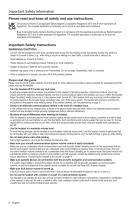
I mportant Safety Information Please read and keep all safety and use instructions. T his product conforms to all applicable Electromagnetic Compatibility Regulations 2016 and all other applicable UK regulations. The complete declaration of conformity can be found at: www.Bose.com/compliance Bose Corporation hereby declares that this product is in compliance with the essential requirements per Radio Equipment Regulations 2017 and all other applicable UK regulations. The complete declaration of conformity can be found at: www.Bose.com/compliance Important Safety Instructions...
Open the catalog to page 2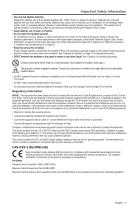
Important Safety Information • Use only AA alkaline batteries. Replace the batteries only with AA alkaline batteries (IEC LR06). There is a danger of explosion if batteries are incorrectly replaced with any other battery chemistries. Batteries may cause a fire or chemical burn if mishandled. Do not recharge, disassemble, heat, or incinerate batteries. Dispose of used batteries properly, following any local regulations. The headset will not operate properly if used with any battery source other than the Bose A20 Aviation Headset control module. • Keep batteries out of reach of children. •...
Open the catalog to page 3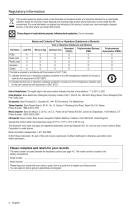
This symbol means the product must not be discarded as household waste, and should be delivered to an appropriate collection facility for recycling. Proper disposal and recycling helps protect natural resources, human health and the environment. For more information on disposal and recycling of this product, contact your local municipality, disposal service, or the shop where you bought this product. Please dispose of used batteries properly, following local regulations. Do not incinerate. Date of Manufacture: The eighth digit in the serial number indicates the year of manufacture; “1” is...
Open the catalog to page 4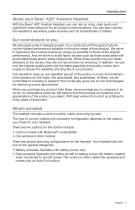
About your Bose® A20® Aviation Headset With the Bose® A20® Aviation Headset, you can rely on crisp, clear audio and s ignificant noise reduction for all cockpit communications. You can also connect the headset to secondary audio sources such as smartphones or tablets. Our commitment to you We take great pride in designing each of our products with the goal of providing the highest performance possible in the price range of that product. We strive to reproduce the musical sounds as closely as possible to those of the original performance. And we strive to avoid flashy sounds such as those...
Open the catalog to page 7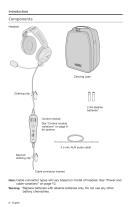
Components Headset Carrying case Clothing clip 2 AA alkaline batteries* Control module See “Control module variations” on page 9 for options 3.5 mm AUX audio cable Second clothing clip Cable connector (varies) Note: able connector types will vary based on model of headset. See “Power and C cable variations” on page 10. Warning: * eplace batteries with alkaline batteries only. Do not use any other R battery chemistries.
Open the catalog to page 8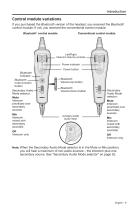
Control module variations If you purchased the Bluetooth version of the headset, you received the Bluetooth control module. If not, you received the conventional control module. Bluetooth® control module Conventional control module Bluetooth indicator Bluetooth multi-function button Secondary Audio Mode selector: Mute Intercom prioritized over secondary sources Mix Intercom mixed with secondary source(s) Off Intercom only Auxiliary (AUX) audio input Secondary Audio Mode selector: Mute Intercom prioritized over secondary sources Mix Intercom mixed with secondary source(s) Off Intercom only...
Open the catalog to page 9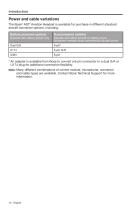
Power and cable variations The Bose® A20® Aviation Headset is available for purchase in different standard aircraft connector options, including: * An adapter is available from Bose to convert a 6-pin connector to a dual G/A or U174 plug for additional connection flexibility. Note: Many different combinations of control module, microphone, connector and cable types are available. Contact Bose Technical Support for more information.
Open the catalog to page 10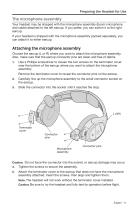
The microphone assembly Your headset may be shipped with the microphone assembly (boom microphone and cable) attached to the left earcup. If you prefer, you can switch it to the right earcup. If your headset is shipped with the microphone assembly packed separately, you can attach it to either earcup. Attaching the microphone assembly Choose the earcup (L or R) where you want to attach the microphone assembly. Also, make sure that the earcup connector pins are clean and free of debris. 1. Use a Phillips screwdriver to loosen the two screws on the terminator cover near the bottom of the...
Open the catalog to page 11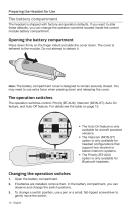
The battery compartment The headset is shipped with factory-set operation defaults. If you want to alter these defaults, you can change the operation switches located inside the control module battery compartment. Opening the battery compartment Press down firmly on the finger indent and slide the cover down. The cover is t ethered to the module. Do not attempt to detach it. Note: The battery compartment cover is designed to remain securely closed. You may need to use extra force when pressing down and releasing the cover. The operation switches The operation switches control: Priority...
Open the catalog to page 12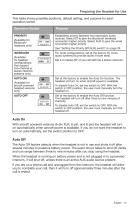
This table shows possible positions, default setting, and purpose for each operation switch. Auto On With aircraft powered versions (5-pin XLR, 6-pin, and 8-pin) the headset will turn on automatically when aircraft power is available. If you do not want the headset to turn on automatically, set the switch position to OFF. Auto Off The Auto Off feature detects when the headset is not in use and shuts it off after several minutes to preserve battery power. The exact time it takes to shut off varies and can range between three to nine minutes after you stop using the headset. When the headset...
Open the catalog to page 13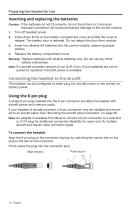
Inserting and replacing the batteries Caution: f the batteries do not fit correctly, do not force them in. Forcing an I 1. i mproper connection will cause permanent damage to the control odule. m Turn off headset power. Press down firmly on the battery compartment cover and slide the cover to release. The battery door is tethered. Do not detach the door from module. Insert two alkaline AA batteries into the control module, observing proper polarity. Replace the battery compartment cover. Warning: eplace batteries with alkaline batteries only. Do not use any other R battery chemistries....
Open the catalog to page 14All BOSE catalogs and technical brochures
-
BOSE PRODUCT CATALOGUE 2016
11 Pages


